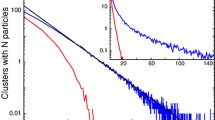Abstract
In the three-atomic Frenkel model, the intermediate atom is placed in the middle between the two end atoms, where a potential energy minimum is localized for small lengths of the straight-line segment; the intermediate atom is shifted from the midpoint where a potential energy maximum arises toward one of the end atoms as the segment length increases. In the model length-temperature phase diagram, a region of the first-order phase transitions terminated by a critical point lying on the length axis is observed. In the present paper, the three-atomic model with dissimilar end atoms is considered. In this case (for example, in the absence of attraction to one of the end atoms), the potential energy can have only one minimum, and the first-order transitions are absent. According to dynamic theory, the calculated behavior of the middle atom that depends on the temperature for the constant length demonstrates the phenomenon of supercritical transition connected, according to V. K. Semenchenko, with a passage of the stability determinant through a minimum without stability loss. If the force applied to the end atoms is set rather then the model length, equations are solved for the displacement of atoms, rms oscillation amplitude, and deformation by means of expansion in a series in the anharmonicity coefficients, and the result obtained demonstrates a linear temperature dependence of the coefficient of elasticity.
Similar content being viewed by others
References
Ya. I. Frenkel, Liquid State and Theory of Melting. Selected Works, Vol. 2 [in Russian], Publishing House of the USSR Academy of Sciences, Moscow, Leningrad (1958), pp. 269–279.
Ya. I. Frenkel, Introduction to the Theory of Metals [in Russian], State Technical and Theoretical Press, Leningrad, Moscow (1948), pp. 162–171.
V. Kh. Kozlovskii, Mechanism and Kinetics of Crystallization [Russian translation], Nauka i Tekhnika, Minsk (1969), pp. 154–164.
M. Born and M. Geppert-Myer, Theory of Solids. Dynamic Theory of Crystal Lattices [in Russian], United Scientific and Technical Press, Leningrad, Moscow (1938).
S. A. Boguslavskii, Selected Works in Physics [in Russian], State Physical and Mathematical Press, Moscow (1961).
V. Kh. Kozlovskii, Russian Physics J., No. 4, 353–359 (1991).
V. Kh. Kozlovskii, Dynamic Molecular Theory of Phase Transitions in Ferroelectric Crystals, Doctoral Thesis in Physical and Mathematical Sciences, Moscow State Institute of Electromechanics, Moscow (1994).
V. K. Semenchenko, Selected Chapters in Theoretical Physics [in Russian], Obrazovanie, Moscow (1966).
J. Sivardiere, Am. J. Phys., 54, No. 2, 172–177 (1986).
J. Sivardiere, Am. J. Phys., 65, No. 6, 567–568 (1997).
G. Fletcher, Am. J. Phys., 67, No. 1, 74–81 (1997).
Author information
Authors and Affiliations
Corresponding author
Additional information
__________
Translated from Izvestiya Vysshikh Uchebnykh Zavedenii, Fizika, No. 3, pp. 16–26, March, 2007.
Rights and permissions
About this article
Cite this article
Kozlovskii, V.K. A three-atomic model of crystals with supercritical behavior. Russ Phys J 50, 213–227 (2007). https://doi.org/10.1007/s11182-007-0030-7
Received:
Issue Date:
DOI: https://doi.org/10.1007/s11182-007-0030-7




